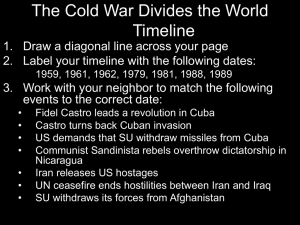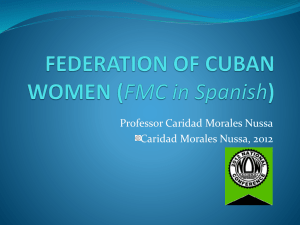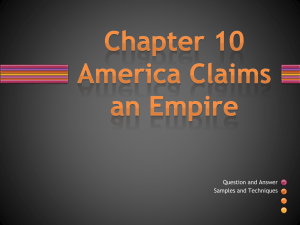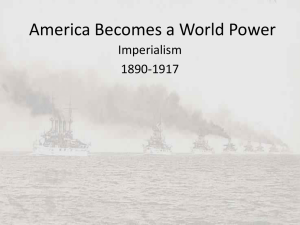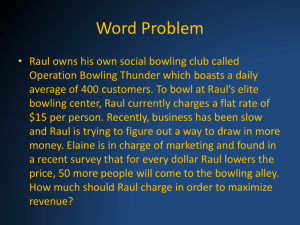Cuba`s Economic Reform Process under President Raul Castro.
advertisement
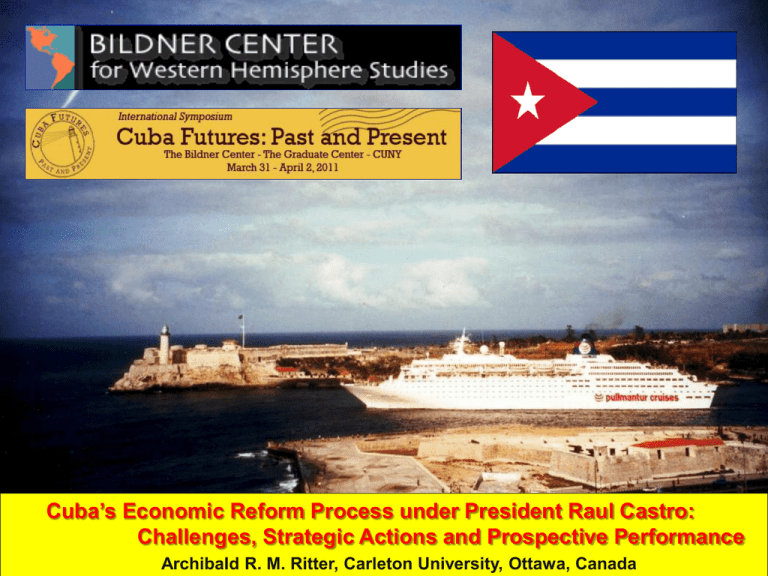
Cuba’s Economic Reform Process under President Raul Castro: Challenges, Strategic Actions and Prospective Performance Archibald R. M. Ritter, Carleton University, Ottawa, Canada Objectives: – To review Cuba’s current economic situation; – To outline and analyze the new approach of the Government of Raul Castro; – To speculate on possible outcomes from the Sixth Party Congress Main Argument: – Current economic situation is exceedingly difficult; – Strategic re-orientation so far: right direction, still modest; slow implementation; – Definitive design awaits Sixth Party Congress; – Deliberate steady reform process is now probable Outline: I. Cuba’s Current Economic Situation: Longer term economic performance; Short term conjunctural circumstances II. The Reform Approach so far: Character, Strengths, and Weaknesses; Sustainability of the reform process III. Congress: “Lineamientos” or Guidelines; Possible results I. Context for the Reforms of 2010-11 1. General economic performance during the “Special Period”, 1990-2011: – Human development has been positive; – Alleged success: growth and recuperation; But: – Real Income per person has not risen in pace with alleged economic growth; – Production of Goods – as opposed to services – has not improved; – A range of problems continues Source: ONE, AEC various issues and UN ECLAC, Preliminary Overview, various issues Although the Cuban economy surpassed the levels of 1990, the real value of wages in Cuba remained at around 40 percent of the 1989 level (see Chart 3). But: Cuba’s GDP statistics are dubious: – The Oficina Nacional de Estadísticas (ONE) adopted a new approach to measuring GDP (ONE 2006, Table 2.1.2.30). – Increased the value of “government consumption” by 76.6 percent—for health, mainly – thereby raising Cuba’s GDP per capita and increasing its growth rate; – UNDP HDR 2010 disbelieved Cuba’s GDP per capita and omitted Cuba from all Human Development Indices Actual economic performance: weak Chart 2 Cuba: Real Inflation-Adjusted Wages, 1989-2009 (Pesos, Moneda Nacional Vidal Alejandro, Pavel, “Politica Monetaria y Doble Moneda”, in Omar Everleny Perez et. al., Miradas a la Economia Cubana, La Habana: Editorial Caminos, 2009 Average formal economy wage is around 25% of the 1989 level; Minimal recuperation since 1993 Some receive other income – remittances; – self-employment – home produced G&S; – goods in kind from the state; – underground economy; – pilferage; Those without other income sources: deep poverty Source: NU CEPAL, 2000 Cuadro A.86; ONE, 2010 Table 11.4 Sugar sector collapse: major economic catastrophe – Regional and local development impacts; – Cluster of input-providing and output processing activities collapse; – 32.1% increase in idle farm land (to 1.2 million hectares); – Reduced foreign exchange earnings +/- $3.5 billion in 2010; – By-product electricity generation reduced; – Increased unemployment; – Ethanol production foregone Chart 4. Cuban Exports and Imports of Foodstuffs, 1989-2008 (excluding Tobacco and Alcoholic Beverages) (Millions CUP) Food Imports Source: NU CEPAL, 2000 Tables A.36 and A.37, and ONE, AEC, Various Years. Source: ONE AEC, 2004, Table 11.1 and 2IX.1, and various issues Note: Data for 1990-1997 are not available Causes of De-Industrialization: The policy environment (Dual monetary and exchange rate systems); A grossly overvalued exchange rate; The 1990-93 melt-down; Technological inheritance from the USSR; Unfair competition from China with its grossly undervalued exchange rate Source: ONE, 2009 Table 5.7 Source: ONE 2009 Table 8.12 Source: UN CEPAL, 2000 Table A.38 and Mesa-Lago, 2000. 366 Low Investment Levels Insufficient investment, – 8.5% of GDP (compared with 21.9% for Latin America in 2008); Insufficient maintenance – Run-down capital stock: housing infrastructure, etc. Chart 9 Unemployment and Underemployment in Cuba, 1988-2010 Source: Carmelo Mesa-Lago:Convirtiendo el Desempleo Oculto en Visible en Cuba” Espacio Laical, Havana Cuba. And Comisión Económica para América Latina y el Caribe (CEPAL). 1997, 2000. La Economía Cubana: Reformas Estructurales y Desempeño en los Noventa (México DF: Fondo de Cultura Económica, 1a y 2a ediciones). Causes of Economic Problems Not Weak Human Development Not laziness or weak entrepreneurship Instead: problems are due to – Misguided policies; – Institutional deformations: excessive expansion of state sector; – Insufficient role for market mechanism; – Innumerable bureaucratic controls in labor, product, financial and capital markets; Induce people to undertake unproductive actions Thence the underground economy, pilferage, black markets A Central Policy Mess-Up: The Monetary and Exchange Rate System A half-century of pathology and inconvertibility Twenty years of the dual monetary and exchange rate systems Results: – Dysfunction of general environment of incentives; – Deformation of people’s lives and work; – Damages to the economy and people’s well-being International Economic Context: 2008-10 Continuing though modified US Embargo Major Negative External Shocks, : o Collapse of nickel prices (now recovered); o Lower sugar prices (now recovered); o Lower petroleum prices: Reduced viability of off-shore oil development => postponement of exploration and development Reduced viability of sugar-based ethanol => postponement Reduced capability of Venezuela to continue transfers to Cuba; o Reduced credit availability Positive External Impacts in 2010: o Lower Oil import Costs (but some oil was already subsidized by Venezuela) but increasing prices in 2011 o Somewhat reduced food import costs, but increasing in 2011; On Balance: A Negative Impact, (now partly in reversal) Reduced Foreign Exchange Availability Negative Macroeconomic shock The immediate context for Cuban citizens: Income security of the ration book is being phased out; Higher prices for many basic staple products; Uncertain employment prospects for many; A general feeling of economic vulnerability II. Raul Castro’s Approach to Reform “In socialism, it is indispensable that in economic plans, the assignation of resources be matched strictly to the available resources. We cannot hope that 2 plus 2 are 5. 2 plus 2 are 4. In fact, sometimes, in socialism, 2 plus 2 comes out to 3.” “We confront unpleasant realities, but we are not closing our eyes to them. We are convinced that we must break dogmas and we affirm with firmness and confidence the implementation, already in process, of ‘our economic model’”. Raul Castro “… Without an increase in efficiency and productivity, it is impossible to raise salaries, increase exports, substitute for imports, increase food production, and sustain definitively the enormous social expenditures of our socialist system.” Raúl “In the economic policy that is proposed, socialism is equality of rights and opportunities for the citizens, not egalitarianism” “Lineamientos” Included in the “Projecto de Lineamientos de la Politica Economica y Social” or “Draft Guide for Economic and Social Policy” and the Legislation of October 2010 on Employment and Microenterprise; Pre-2006 Complacency “Draft Guide for Economic and Social Policy” of October 2010 “Draft Guide for Economic and Social Policy”of October 2010 Broader Problem-identification is implicit in the “Projecto” and includes: Putting unused lands into productive use, Raising agricultural yields, Developing new mechanisms to reverse industrial and infrastructural de-capitalization (Undertake studies in order to) eliminate monetary dualism, and Provide improved capacities for more decentralized regional development. Recover traditional exports “Contours” of Economic and Social Policy (291 guidelines, goals, or recommendations) I II III IV V VI VII VIII IX X XI XII Economic Management Model (38) Macroeconomic Policies (25) External Economic Policies (44) Investment Policy (13) Science, Technology and Innovation Policy (7) Social Policy (36) Agro-industrial Policy (31) Industrial and Energy Policy (37) Tourism Policy (13) Transport Policy (18) Construction, Housing, and Water Policy (14) Commercial Policy (9) Essential Character: – Purely economic, no political elements – Ostensibly to promote popular debate. – “Guidelines” only; Not intended as a “plan”; Maybe a “Pre-strategy” – Ambitious and comprehensive – A statement of aspirations; a “Wish-list” or maybe an “agenda” – No priorities indicated – No sequencing of policies or investments – No coordination Does it suggest a “Viet Namese Model” or a “Chinese Model”? Only partially Some Notable Guidelines: Establish wholesale markets for state, cooperative and self-employment enterprises (9) Greater autonomy for state enterprises re investment (13) Liquidation of Insolvent enterprises. (16) Workers incomes in state enterprises to be linked to enterprise performance (19) Monetary and exchange rate unification will be “advanced” (54) (more studies) The taxation system will be advanced in terms of progressivity and coverage, (56 and 57) – Real estate taxation at municipal level Centralized price determination will be maintained. Recover the place of work as the fundamental means of contributing to the development of society and the satisfaction of personal and family needs. (130) Modify the structure of employment, reducing inflated state sector staffing and increasing employment in the non-state sector (158-159) Eliminate the ration book. (162) Improve agriculture; (166, 174, 194.) Promote export-oriented industry (197) Develop new industries such as tires, construction materials and metallurgy (213, 215, 216) Restructuring retailing and wholesaling. (283-291) The Core of the New Strategy so far: 1. First: downsize the state sector Lay off redundant workers; 2. Second, re-absorb displaced workers in the self-employment and cooperative sector; Shock Therapy? Ultra-Neo-Liberal? A “slap-in the-face” for Fidel? The old approach was not working, despite Fidel’s September assertions; An Amazing Reversal of Fortune: Cuenta-Propistas are now longer stigmatized outcasts but have become the designated saviors of the Cuban economy! Key Question: Can the micro-enterprise and cooperative sector absorb 500,000 to 1,200,000 apparently redundant state sector workers and rescue the Cuban economy? 2. Policy Changes towards Micro-Enterprise: a) Range of activities: a small increase b) Regulatory framework: some relaxation c) Tax regime: minor change, and continuing rigor d) Licensing: significant liberalization e) Media and political environment “destigmatized” (a) Range of activities: – 178 finely defined activities allowed; Compared with157 after 1993; Then reduced by 40 in 2003 Includes 16 minor activities in Historic Old Havana Minor increase from pre 2005 Anything not specifically permitted is prohibited – Mainly low-tech activities; – Virtually all professional self-employment remains prohibited; (b) Regulatory Framework: “From 12 to 20 chairs” Definition of Infractions and Penalties Virtually unchanged; See Decree-Law 274. September 30, 2010 But license removal and confiscation of equipment and products is eliminated Prohibitions: some Relaxation (a) (b) (c) (e) (f) Access to credit may be possible; Some Improved access to purchased inputs, in future Some minor limits extended: 12 to 20 Paladar chairs; Increased limits on hiring employees; Petty restrictions continue, Prohibitions: some continued: (a) No intermediaries (b) No advertising (c) No reasonable access to foreign exchange or imports (c) Tax Regime: Complex, Punitive, Dis-incentivating For 91 small-scale activities , “Simplified Formula” can be used: up-front monthly payments For larger enterprises: Four Taxes: 1. Sales Tax on Goods and Services for 87 of the 178 activities (10% of Gross Revenues) 2. Tax on Hiring of Workers 3. Social Security Tax 4. Income Tax: Tax rates: from 25% to 50% Tax Base: 60% to 90% of Gross Revenues Effective rate can exceed 100% Evaluation of New Tax Arrangement 1. Highly complex for the 87 larger types of firms; 2. High “effective taxation” rate will promote non- compliance 3. Tax on hiring workers will discourage hiring and legal job-creation 4. Complexity and high rates will discourage underground enterprises from becoming legal 5. Enterprise “Stunting” will continue: expansion and economies of scale discouraged or prohibited Additional Positive Changes: Broadened eligibility for self employment: non-retired or non-disabled may obtain licenses Rental of facilities from citizens or the state is easier Sales to state entities is now possible; Use of banking facilities and bank credit will be possible; Cooperative ventures are now encouraged (taxis, beauticians) Can the Microenterprise and Co-op sectors generate 1.2 million new jobs by Dec. 2012? The positive side: 1. Stigmatization reversed: from outcasts to heroes of the economic recovery 2. Licensing liberalized will be helpful; 3. Small increase in permitted activities; 4. Tax change: increased deductibility of costs from gross revenues for taxes has for some activities; 5. Rental of facilities from citizens or the state is easier 6. Regulations eased somewhat; 7. Harsh punishments for infractions are cut, though fines remain; 8. Use of banking facilities and bank credit will be possible; 9. Improved access to inputs perhaps in future On the Negative Side: 1. Heavy taxation continues: firms will remain underground; 2. Tax on hiring workers will discourage job creation; 3. Narrow definition of legal activities will limit enterprise and job creation; 4. Exclusion of high-tech and professional activities block development of knowledge-intensive enterprises and wastes the training of the highly educated • Innovation throughout the economy blocked 5. Some bizarre restrictions and prohibitions remain 6. Restrictions on hiring workers remain Stunting of enterprises will prolong inefficiencies Disincentives to legalization of underground activities continue Contempt for the Law and non-compliance is promoted by continuation of apparently frivolous restrictions III. Results? Expansion of Small Enterprise and job creation has been too slow to absorb 500,000 by March 1, 2011 • 171,000 new licenses by March 10, 2011 Proposed shock therapy re employment was too brutal to be implemented: Firing of workers (500,000 by March 31) has been postponed till after Congress. Probable pressures to reverse the liberalization process if it is not working; Source: ONE: Anuario Estadistico de Cuba, various issues New Paladar, February 2011 Repairing a Bicytaxi Other Policy Initiatives: July 2006-October 2010 2006 Permission for Cuban citizens to use tourist hotel facilities Permission to acquire personal cellular phone contracts Permission to rent cars previously reserved for foreigners Relaxation of rules regarding purchase of computers, DVD players, etc. “Resolution on Regulations for Labor Discipline” 2007 Legalization of hard‐currency salary supplements to Cuban employees of foreign joint ventures 2008 Decree-Law No. 259: ten-year leases of unused state land to small farmers Decree Law No. 260, Financial incentives to attract teachers back to their profession 2009 Replacement of Fidel Castro’s economic team and resignation of the President of the Central Bank Proposal to reduce subsidization of rationed products Replacement of worker’s dining facilities with an income increase 2010 Relaxation of restrictions on private taxis Experiment with cooperative beauty and barber shops Markets for inputs for small farmers Raising of retirement ages from 55 to 60 for women and from 60 to 65 for men Liberalization of sale of building materials to citizens Legalization of 99-year leasing of land to foreign tourist companies (August 13, 2010) Announcement of Lay-offs of 500,000 state sector workers to be incorporated into self-employment. (September 1) Is the Reform Process Sustainable? “Fidelistas” are likely running some interference; e.g. Jose Luis Rodriguez: the Cuban economy is NOT in crisis. “…esencialmente, el modelo se puede sostener, la prueba es que la economía ha seguido creciendo, desde el año 1994; Es verdad que la tasa de crecimiento en 2009 fue de 1.4% y en 2010 llegó a 2.0%, pero el hecho es que no hay un retroceso a pesar de todos estos problemas. Sustainability of the reform process Probably Not Reversible The “Fidelista Model” is discredited Fidel himself is irrelevant and discredited; “Fidelistas” are also discredited By current realities, By the “Proyecto de Linamientos…” By Raul’s statements and speeches regarding the need for a new economic approach By publicity re the need for a new approach Fidelista Ministers have been mostly replaced by Raulistas; – Raul’s military colleagues have moved into management throughout the economy Raul and the military: pragmatic since the 1990s But management militarization is also problematic – Raul appears to have emerged from the shadow of his elder brother; Raul seems to want his own economic model, Raul seems to want his own legacy In summary Low probability of sufficient job creation by the micro-enterprise and cooperative sectors to 1,200,000 in the next few years. Further liberalization will be necessary: 1. Modify the tax regime; • • Eliminate tax on hiring workers; Permit all costs to be deductible from gross revenues for calculating taxable income; 2. Broaden of permitted activities; 3. Relax vexatious regulations; 4. Drop hiring restrictions 5. Establish microcredit institutions (international assistance is available for this) 6, Improve access to wholesale input purchase 7. Legalize “Intermediaries” (permitting specialization between producers and venders) 8. Permit Advertising 9. Establish a “Ministry for Small Enterprise”!!! III. Sixth Party Congress: Discussion oriented around “Lineamientos” Producing a coherent strategy or “plan of action” from the “Guidelines” will be difficult; Conversion of a wish-list into a strategy with concrete measures? Policy priorities, sequencing of measures? Results difficult to predict; Wait and See – For some, expectations for significant measures are low: rhetorical sound and fury, but little implementation – For others – dissident and mainstream analysts, signs are encouraging – Climate of opinion: decisively on the reform olption My Prediction: A document based on the Lineamientos will be approved – probably already written – including: – Statement of more specific objectives; – Indication of priorities; – Inclusion of some “sequencing” of tasks; – Focus on productivity and getting the incentive structure right! Some of the Main Elements of the reform process – Further liberalization for small enterprise – Down-sizing of state sector esp. in areas that work well with small enterprise – Greater reliance on market mechanisms and market-determined prices – General subsidization via ration book to be replaced by targeted social assistance – Movement towards monetary and exchange rate unification Optimistic again! Raul seems pragmatic and deliberative; accepts hard truths and takes strong actions; Fidelistas are in (permanent?) eclipse; Problems have to be dealt with; Generational change is under way; Climate of opinion has changed; Heightened popular expectations for change are increasingly difficult to ignore; Some toleration with containment of critical views, despite intensifying “Cyber-wars” and Blogger Battles; Reform process will continue! But risks are significant To Conclude: Economic situation is difficult; Policy changes are in the right direction but reforms so far are timid; – Excessively harsh re lay-offs – Excessively modest re private sector liberalization A dynamic towards further reform measures has been set in motion, will be propelled forward at the Sixth Party Congress and will continue.



